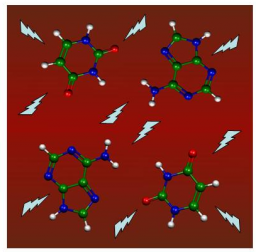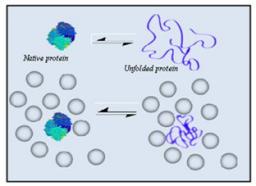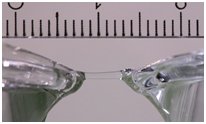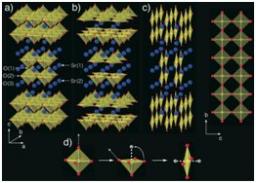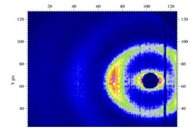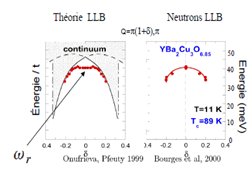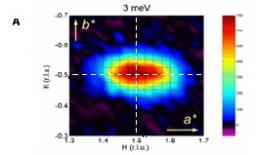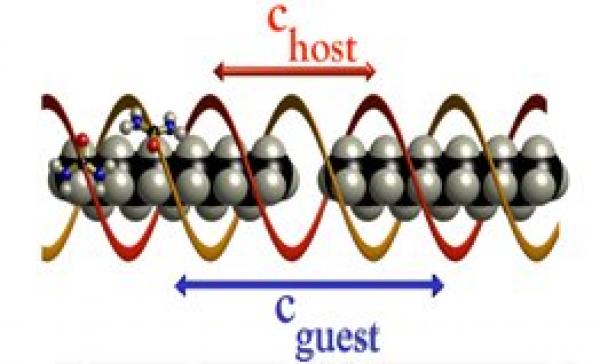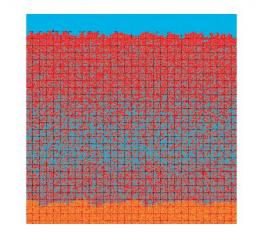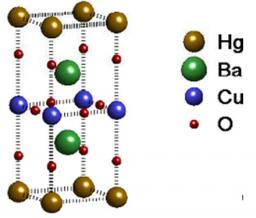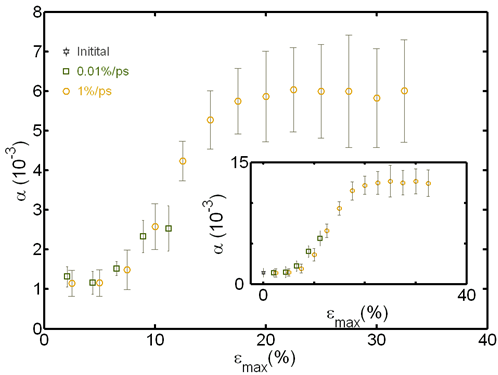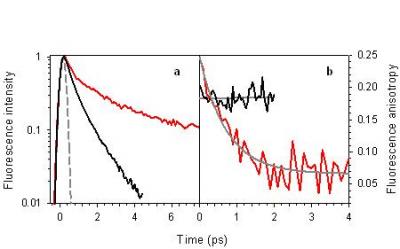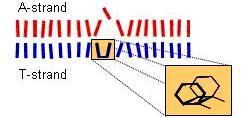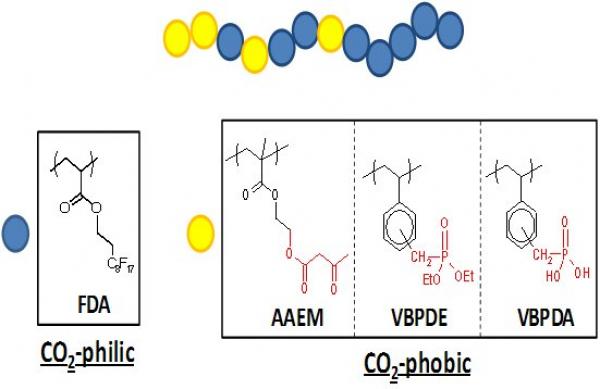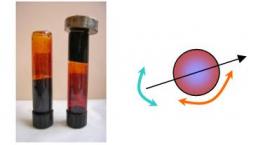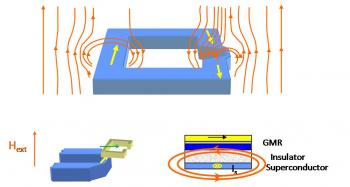2010
The characterization of the primary events that are induced by absorption of UV radiation by DNA is important in two respects. On the one hand, it sheds light on the fundamental processes involved in the UV-induced damage to the genetic code. On the other hand, the determination of the factors that govern the DNA optical properties may contribute to the design of DNA-inspired materials for optoelectronics.
In this context, we study various DNA systems in solution:
► monomeric chromophores: bases, nucleosides, nucleotides
A detailed experimental and computational study of the absorption and fluorescence spectra of 5-aminouracil (5 AU) and 6-aminouracil (6 AU) in aqueous solution is reported. The lowest energy band of the steady-state absorption spectra of 5 AU is considerably red-shifted, noticeably less intense, and broader than its counterpart in uracil (U). On the contrary, the 6 AU lowest energy absorption peak is close in energy to that of U, but it is much narrower and the transition is much more intense. The emission properties of 5 AU, 6 AU, and U are also very different. Both amino-substituted compounds exhibit indeed a much larger Stokes shift as compared to U, and the emission band of 5 AU is much narrower than that of 6 AU. Those features are fully rationalized with the help of PCM/TD-PBE0 calculations in aqueous solution and MS CASPT2/CASSCF calculations in the gas phase. A stable minimum on the potential energy surface of the lowest energy bright state is found for 5 AU, both in the gas phase and in aqueous solution. For 6 AU a barrierless path leads to the conical intersection with the ground electronic state, but a nonplanar plateau region is predicted in aqueous solution, which is responsible for the very large Stokes shift. Some general considerations on the excited-state dynamics of uracil derivatives are also reported.
Modeling DNA excitons
We have modeled the Franck-Condon excited states of DNA duplexes and G-quadruplexes. Our calculations were performed in the frame of the exciton theory combining molecular dynamics simulations (collaboration with Richard Lavery and Krystyna Zakrzewska) and data from quantum chemistry (atomic transition charges for the calculation of dipolar coupling). The most important outcome is that, despite conformational disorder, the dipolar coupling alone induces delocalization of the excitation energy over several bases. The extent of delocalization depends on the base sequence; it increases when going from AT duplexes to GC duplexes and is relatively higher in G-quadruplexes.
Optical properties of guanine nanowires: experimental and theoretical study,
P. Changenet-Barret, E. Emanuele, T. Gustavsson, R. Improta, A.B. Kotlyar, D. Markovitsi, I. Vaya, K. Zakrzewska and D. Zikich
J. Phys. Chem. C 114 (2010) 14339–14346
Exciton states of dynamic DNA double helices: alternating dCdG sequences,
E. Emanuele, K. Zakrzewska, D. Markovitsi, R. Lavery and P. Millie
J. Phys. Chem. B 109 (2005) 16109-16118
UV spectra and excitation delocalisation in DNA: influence of the spectral width,
E. Emanuele, D. Markovitsi, P. Millié and K. Zakrzewska
ChemPhysChem 6 (2005) 1387-1392
Influence of conformational dynamics on the exciton states of DNA oligomers,
B. Bouvier, J.P. Dognon, R. Lavery, D. Markovitsi, P. Millié, D. Onidas and K. Zakrzewska
Z Phys. Chem. B 107 (2003) 13512-13522
Dipolar coupling between electronic transitions of the DNA bases and its relevance to exciton states in double helices,
B. Bouvier, T. Gustavsson, D. Markovitsi and P. Millié
Chem. Phys. 275 (2002) 75-92.
Guanine rich DNA strands, as those encountered at the extremities of human chromosomes, have the ability to form four-stranded structures (G-quadruplexes) whose building blocks are guanine tetrads. G-quadruplex structures are intensively studied in respect to their biological role, as targets for anticancer therapy and, more recently, to their potential applications in the field of molecular electronics.
We have shown that self-association of guanines gives rise to exciton states. As a consequence, ultrafast excitation transfer takes place within G-quadruplexes. Self-association of guanines slows down the fluorescence decays and increases the fluorescence quantum yield. The relaxation of ππ* states toward lower energy charge transfer excited states, involving guanines on different tetrads, depends on the nature cations in the central cavity; it is facilitated by Na+ ions, which are smaller and more mobile compared to K+ ions.
We study the excited state relaxation of the DNA/RNA building blocks (bases, nucleosides, nucleotides) and their fluorescent analogs. We strive for a better insight in the very efficient internal conversion occurring after UV excitation and its dependence on the molecular structure and the solvent.
In general, the excited state lifetimes of these monomeric chromophores are so short that ultrafast techniques are needed. We use in particular femtosecond UV fluorescence spectroscopy.
Following the synthesis by the ribosome, to carry out its biological function, a protein much fold into a single, well defined conformational state: the native state. Protein folding is thus the physico-chemical process by which a polypeptidic chain undergoes a structural change from an ensemble of coil like structure up to the unique structure encoded in its amino-acid sequence. This process is fascinating and remains one of the most challenging problems of structural biology. Protein misfolding is involved in number of pathologies such as BSE an Alzheimer diseases. More...
Light-harvesting antennae are pigment-protein complexes involved in light-absorption and excitation energy transfer (EET) to the so-called "reaction center" complexes, where the photochemical processes of photosynthesis take place. C-phycocyanin (C-PC) is one component of the phycobilisome, the light-harvesting system of cyanobacteria [1]. In phycobilisomes, EET is a highly efficient key event [2-3], where light-induced dynamics of the antenna pigment/protein complexes may play a role [4-7].
To detect fast and localized protein motions at room temperature, related to light absorption and EET in the isolated pigment/C-PC protein system, as well as to investigate the timescale of such dynamical changes, we developed a new experimental setup on the time-of-flight spectrometer MIBEMOL (LLB, France). This new "time-resolved" method was technically challenging, since we had to synchronize pulsed inelastic neutron scattering measurements with repetitive light excitations. The principle of the experimental setup is shown in Fig. 1. The laser was fixed outside the sample well of MIBEMOL spectrometer, perpendicularly to the neutron beam and in front of the detectors (Fig. 1A). The photon beam was directly aimed on the sample through the 10 mm-diameter hole of an "integrating sphere" (Fig. 1, B and C), without any additional optical device. We used a spherical and hollow aluminium chamber, containing a highly reflective and diffusing interior coating, to illuminate the sample inside uniformly. More...
In 1893 Sir William Armstrong reported a remarkable experiment: if a high voltage is established between two wine-glasses filled to the brim with pure water and connected by a cotton thread, a rope of water is formed and remains suspended between the lips of the two glasses. This "water bridge" can subsist for a few seconds even once the thread has been removed [1].
Recently, a group of physicists from Graz University, Austria [2] succeeded on establishing a bridge (without any thread!) between the two glasses under a voltage of 20 kV. The length of the bridge may reach values larger than 1 cm, its diameter is of the order of a few mm and the lifetime currently exceeds 1 hour. Under the effect of the electrical field, the local temperature increases and reaches 60° C, a temperature sufficient to break the bridge. More...
Voir aussi le fait marquant :
- Des neutrons pour étudier la structure de l'eau : le pont d'eau lourde
/ See also the IRAMIS highlight:
- Neutrons to investigate the structure of water : the heavy water bridge
The concept of "spin ladder" originally appeared to study the theoretically still controversial antiferromagnet (AF) 2D square lattice in high temperature superconducting cuprates starting from a well understood 1D AF chain [1-2]. They can been schematized as an array of finite number of coupled chains .The motivation of theoretical investigations has been to test how the one-dimensional (1D) S=1/2 AF chain system (n=1), that is rigorously solved even when doped with carriers, could be connected to the 2D square lattice (n=∞) that in turn encounters various theoretical difficulties and is far from being understood. Experimentally, Srn-1CunO2n-1 has been the only example representing a generalized spin-ladder system [3-5]. More...
The use of agricultural resources for industrial purposes will undoubtly be one of the major challenges of the 21 st century. Organic biosynthons used in chemistry should progressively replace those coming from fossil fuels. Our work on dispersions of fatty acids and hydroxylated derivatives forms part of these efforts in that it seeks to demonstrate the potential contribution of fatty acids (which may be extracted from plants) as a new class of surface active agents. Dispersions of fatty acid and their hydroxyl derivatives are thus studied in solution in order to generate a new class of surface active agents for foaming and emulsifying properties.
However, it is known that fatty acids and their hydroxylated derivatives are insoluble in water. Our initial studies thus targeted the physiochemical conditions which would enable dispersion of these compounds. Using commercial fatty acids as model systems, we produced dispersions by using a large variety of counter-ions such as soluble organic amines (ethanolamine, lysine...). These salts made it possible to obtain homogeneous dispersions with considerable polymorphism, which formed micelles [1], vesicles [2], nanotubes [3, 4], cones [5] and torsades [6]. Preliminary studies in foams and emulsions have demonstrated that their stability differs as a function of polymorphism [7]. More...
This work is part of a theoretical project which aims to unravel the mechanism at work in the high temperature cuprate superconductors. In the recent article [1] we have studied the role of spin fluctuations, and namely of the collective spin mode, for the superconducting pairing and numerous electronic anomalies observed in cuprates. This mode strongly coupled to the electrons (which develops in the vicinity of the antiferromagnetic wave vector and has an anomalous downward dispersion) was first predicted theoretically [2] and then observed by neutrons [3]. More...
BiFeO3 is a multiferroic materials in which ferroelectric and anti-ferromagnetic orders coexist well above room temperature (TN=643 K, TC=1093 K), with a high polarization (over 100 μC/cm2 [1]). We have shown at the LLB by neutron diffraction that these two order parameters interact and that the magnetization of the material can be modified by the application of an electric field. This opens the way towards the implementation of this material in spintronic devices in which magnetization could be controlled by a small electrical voltage rather than by currents or magnetic fields.
Although magnetoelectric materials have been known for decades, no direct proof of the coupling between the two co-existing physical effects had been reported in the literature. We have demonstrated this magneto-electric coupling by neutron diffraction on BiFeO3 single crystals. One key to success was the exceptional quality of the high purity single crystals which are magnetically and electrically single domain. More...
The strongly interacting conduction electrons can be accurately represented as a gas of weakly interacting electron-like excitations. This description, known as Fermi liquid theory, works for many metallic systems. However, over the past two decades, new types of metallic materials with strongly correlated electrons have been discovered that do not fit this standard description. The list includes the superconducting copper oxides and many other materials. More...
Using conjugated polymers as the active materials in electronic and optoelectronic devices opens up the possibility of fabricating all-polymer devices using solution processing technologies. The fabrication of good quality field-effect transistors (FETs) is crucial to a number of polymer-based devices, such as active matrix displays and integrated circuits. Central to FET operation is the dielectric/semiconductor interface. Here we look at the interface between a polymer gate dielectric and a conjugated polymer, using neutron reflectivity. By using a mixed solvent (toluene/cyclohexane) to deposit the conjugated polymer directly on top of the polymer dielectric we are able to fabricate bilayer FET architectures with systematically controlled interfacial roughness, and study the impact on transistor performance. More...
This study investigates the long term behavior of glasses used for confinement of nuclear wastes. The results have been obtained from a fruitful collaboration between different CEA laboratories (LLB, LIONS, CEA Marcoule) and the Ecole Polytechnique. The corrosion process of the glasses by water creates at the glass surfaces, an alteration porous layer, hydrated and amorphous, called "gel". This gel, which is the result of the release of soluble elements, of hydrolyses and of silica network recondensation can in specific conditions strongly limit the exchange process between the glass and the solution. Our hypothesis to describe this phenomenon is the closure of the gel porosity. More...
The pseudogap region of the phase diagram is an important unsolved puzzle in the field of hightransition-temperature (Tc) superconductivity, characterized by anomalous physical properties below a certain temperature, T*[1]. In contrast to the superconducting temperature Tc which exhibits a dome-like shape, the pseudogap phase is observed only at low doping in the underdoped region of the cuprates phase diagram. There are open questions about the number of distinct phases and the possible presence of a quantum-critical point underneath the superconducting dome. More...
Cindy Lynn ROUNTREE,
Coll: Mehdi TALAMALI, Damien VANDEMBROUCQ, (Laboratoire PMMH, ESPCI, Paris,)
Elisabeth BOUCHAUD (CEA-SPEC)
Stéphane ROUX (LMT, ENS-Cachan/CNRS-UMR 8535/Université Paris VI)
Recently many scientists have dedicated an enormous number of research hours to understanding the structure, the dynamics and the mechanical properties of amorphous material, but despite this effort they remain ill-understood. Unlike the plasticity of crystalline materials, the plasticity of glasses cannot be defined unless a completely novel description is introduced. We have employed the fabric tensor which is commonly used in granular physics and more recently in foams to reveal irreversible deformation in glasses. This work shows how the structure of silica can be irreversibly modified by the application of an external shear stress: under shear plasticity a non-reversible anisotropy sets in and appears stable. Thus providing a new interpretation of the small scale plasticity of glass; as revealed by the fabric tensor, which, to the best of our knowledge, has never been used in this context.
C. L. Rountree, D. Vandembroucq, M. Talamali, E. Bouchaud and S. Roux Plasticity-Induced Structural Anisotropy of Silica Glass Physical Review Letters 102, 195501 (2009)
DNA nanostructures formed by association of four oligonucleotides d(TGGGGT) (TG4T quadruplexes) are studied by steady-state and time-resolved optical spectroscopy with femtosecond resolution using fluorescence upconversion. A comparison between single-stranded and four-stranded structures and the corresponding stoichiometric mixture of non-interacting nucleotides shows how horizontal and vertical organization affects the properties of the excited states. Emission from guanine excimers is observed only for single strands, where conformational motions favor their formation. Quadruplex fluorescence arises from a multitude of excited states generated via electronic coupling between guanines; the average fluorescence lifetime is longer and the fluorescence quantum yield higher compared to those of non-interacting nucleotides. The fluorescence anisotropy recorded on the sub-picosecond time-scale, where molecular motions are hindered, reveal that energy transfer takes place among the bases composing the nanostructure. These results are in line with the conclusions drawn from similar studies on model DNA duplexes.
Franois-Alexandre Miannay, Akos Banyasz, Thomas Gustavsson and Dimitra Markovitsi
J. Phys. Chem. C, 113 (27) (2009) 11760.
Chemical alterations of DNA, if not repaired, may lead to carcinogenic mutations. Structural modifications of the helix around the lesion enable its recognition by repair enzymes. We have used absorption spectroscopy and mass spectrometry to detect structural changes provoked by cyclobutane thymine dimers, the major lesion induced by UV radiation. We found that formation of a cyclobutane dimer in the model duplex (dA)20.(dT)20 destroys base stacking on the adenine strand. The physical background of this novel approach is the existence of charge transfer states among neighboring bases whose contribution to the hypochromism of the helix disappears following destacking.
UV-Induced Structural Changes of Model DNA Helices Probed by Optical Spectroscopy†
Akos Banyasz, Szilvia Karpati, Elodie Lazzarotto, Dimitra Markovitsi and Thierry Douki,
J. Phys. Chem. C, 113 (27), (2009) 11747.
Cindy Lynn ROUNTREE,
Coll: Mehdi TALAMALI, Damien VANDEMBROUCQ, (Laboratoire PMMH, ESPCI, Paris,)
Elisabeth BOUCHAUD (CEA-SPEC)
Stéphane ROUX (LMT, ENS-Cachan/CNRS-UMR 8535/Université Paris VI)
Recently many scientists have dedicated an enormous number of research hours to understanding the structure, the dynamics and the mechanical properties of amorphous material, but despite this effort they remain ill-understood. Unlike the plasticity of crystalline materials, the plasticity of glasses cannot be defined unless a completely novel description is introduced. We have employed the fabric tensor which is commonly used in granular physics and more recently in foams to reveal irreversible deformation in glasses. This work shows how the structure of silica can be irreversibly modified by the application of an external shear stress: under shear plasticity a non-reversible anisotropy sets in and appears stable. Thus providing a new interpretation of the small scale plasticity of glass; as revealed by the fabric tensor, which, to the best of our knowledge, has never been used in this context.
C. L. Rountree, D. Vandembroucq, M. Talamali, E. Bouchaud and S. Roux Plasticity-Induced Structural Anisotropy of Silica Glass Physical Review Letters 102, 195501 (2009)
The improvement of the mechanical properties of polymer films by inclusion of mineral particles is a well known industrial practice used since the end of the XIX century. A classical example is the rubber industry for which the addition of carbon black as fillers permits to increase the elastic modulus of the pneumatics. Nevertheless, the mechanisms which govern the reinforcement properties are still not completely described by experiments and theory.
More recently, the use of fillers of nanometric size and of controlled geometry like colloidal silica allowed significant advances in the understanding of these mechanisms and in the conception of innovative materials. In this context, an original approach is to try to improve and to control the specific properties of the material with an external trigger like a magnetic field. We have obtained polymer films with anisotropic mechanical properties by inclusion of magnetic particles inside the matrix which can be aggregated in a controlled way during the film processing and oriented with an external magnetic field. The orientation of the fillers during the processing condition with the field is a new approach when magnetic composites are usually exploited to modulate the mechanical properties after the synthesis. More...
The concept of "spin ladder" originally appeared to study the theoretically still controversial antiferromagnet (AF) 2D square lattice in high temperature superconducting cuprates starting from a well understood 1D AF chain [1-2]. They can been schematized as an array of finite number of coupled chains .The motivation of theoretical investigations has been to test how the one-dimensional (1D) S=1/2 AF chain system (n=1), that is rigorously solved even when doped with carriers, could be connected to the 2D square lattice (n=∞) that in turn encounters various theoretical difficulties and is far from being understood. Experimentally, Srn-1CunO2n-1 has been the only example representing a generalized spin-ladder system [3-5]. More...
In 1893 Sir William Armstrong reported a remarkable experiment: if a high voltage is established between two wine-glasses filled to the brim with pure water and connected by a cotton thread, a rope of water is formed and remains suspended between the lips of the two glasses. This "water bridge" can subsist for a few seconds even once the thread has been removed [1].
Recently, a group of physicists from Graz University, Austria [2] succeeded on establishing a bridge (without any thread!) between the two glasses under a voltage of 20 kV. The length of the bridge may reach values larger than 1 cm, its diameter is of the order of a few mm and the lifetime currently exceeds 1 hour. Under the effect of the electrical field, the local temperature increases and reaches 60° C, a temperature sufficient to break the bridge. More...
Voir aussi le fait marquant :
- Des neutrons pour étudier la structure de l'eau : le pont d'eau lourde
/ See also the IRAMIS highlight:
- Neutrons to investigate the structure of water : the heavy water bridge
Light-harvesting antennae are pigment-protein complexes involved in light-absorption and excitation energy transfer (EET) to the so-called "reaction center" complexes, where the photochemical processes of photosynthesis take place. C-phycocyanin (C-PC) is one component of the phycobilisome, the light-harvesting system of cyanobacteria [1]. In phycobilisomes, EET is a highly efficient key event [2-3], where light-induced dynamics of the antenna pigment/protein complexes may play a role [4-7].
To detect fast and localized protein motions at room temperature, related to light absorption and EET in the isolated pigment/C-PC protein system, as well as to investigate the timescale of such dynamical changes, we developed a new experimental setup on the time-of-flight spectrometer MIBEMOL (LLB, France). This new "time-resolved" method was technically challenging, since we had to synchronize pulsed inelastic neutron scattering measurements with repetitive light excitations. The principle of the experimental setup is shown in Fig. 1. The laser was fixed outside the sample well of MIBEMOL spectrometer, perpendicularly to the neutron beam and in front of the detectors (Fig. 1A). The photon beam was directly aimed on the sample through the 10 mm-diameter hole of an "integrating sphere" (Fig. 1, B and C), without any additional optical device. We used a spherical and hollow aluminium chamber, containing a highly reflective and diffusing interior coating, to illuminate the sample inside uniformly. More...
Following the synthesis by the ribosome, to carry out its biological function, a protein much fold into a single, well defined conformational state: the native state. Protein folding is thus the physico-chemical process by which a polypeptidic chain undergoes a structural change from an ensemble of coil like structure up to the unique structure encoded in its amino-acid sequence. This process is fascinating and remains one of the most challenging problems of structural biology. Protein misfolding is involved in number of pathologies such as BSE an Alzheimer diseases. More...
The use of agricultural resources for industrial purposes will undoubtly be one of the major challenges of the 21 st century. Organic biosynthons used in chemistry should progressively replace those coming from fossil fuels. Our work on dispersions of fatty acids and hydroxylated derivatives forms part of these efforts in that it seeks to demonstrate the potential contribution of fatty acids (which may be extracted from plants) as a new class of surface active agents. Dispersions of fatty acid and their hydroxyl derivatives are thus studied in solution in order to generate a new class of surface active agents for foaming and emulsifying properties.
However, it is known that fatty acids and their hydroxylated derivatives are insoluble in water. Our initial studies thus targeted the physiochemical conditions which would enable dispersion of these compounds. Using commercial fatty acids as model systems, we produced dispersions by using a large variety of counter-ions such as soluble organic amines (ethanolamine, lysine...). These salts made it possible to obtain homogeneous dispersions with considerable polymorphism, which formed micelles [1], vesicles [2], nanotubes [3, 4], cones [5] and torsades [6]. Preliminary studies in foams and emulsions have demonstrated that their stability differs as a function of polymorphism [7]. More...
This work is part of a theoretical project which aims to unravel the mechanism at work in the high temperature cuprate superconductors. In the recent article [1] we have studied the role of spin fluctuations, and namely of the collective spin mode, for the superconducting pairing and numerous electronic anomalies observed in cuprates. This mode strongly coupled to the electrons (which develops in the vicinity of the antiferromagnetic wave vector and has an anomalous downward dispersion) was first predicted theoretically [2] and then observed by neutrons [3]. More...
This study investigates the long term behavior of glasses used for confinement of nuclear wastes. The results have been obtained from a fruitful collaboration between different CEA laboratories (LLB, LIONS, CEA Marcoule) and the Ecole Polytechnique. The corrosion process of the glasses by water creates at the glass surfaces, an alteration porous layer, hydrated and amorphous, called "gel". This gel, which is the result of the release of soluble elements, of hydrolyses and of silica network recondensation can in specific conditions strongly limit the exchange process between the glass and the solution. Our hypothesis to describe this phenomenon is the closure of the gel porosity. More...
Using conjugated polymers as the active materials in electronic and optoelectronic devices opens up the possibility of fabricating all-polymer devices using solution processing technologies. The fabrication of good quality field-effect transistors (FETs) is crucial to a number of polymer-based devices, such as active matrix displays and integrated circuits. Central to FET operation is the dielectric/semiconductor interface. Here we look at the interface between a polymer gate dielectric and a conjugated polymer, using neutron reflectivity. By using a mixed solvent (toluene/cyclohexane) to deposit the conjugated polymer directly on top of the polymer dielectric we are able to fabricate bilayer FET architectures with systematically controlled interfacial roughness, and study the impact on transistor performance. More...
The strongly interacting conduction electrons can be accurately represented as a gas of weakly interacting electron-like excitations. This description, known as Fermi liquid theory, works for many metallic systems. However, over the past two decades, new types of metallic materials with strongly correlated electrons have been discovered that do not fit this standard description. The list includes the superconducting copper oxides and many other materials. More...
BiFeO3 is a multiferroic materials in which ferroelectric and anti-ferromagnetic orders coexist well above room temperature (TN=643 K, TC=1093 K), with a high polarization (over 100 μC/cm2 [1]). We have shown at the LLB by neutron diffraction that these two order parameters interact and that the magnetization of the material can be modified by the application of an electric field. This opens the way towards the implementation of this material in spintronic devices in which magnetization could be controlled by a small electrical voltage rather than by currents or magnetic fields.
Although magnetoelectric materials have been known for decades, no direct proof of the coupling between the two co-existing physical effects had been reported in the literature. We have demonstrated this magneto-electric coupling by neutron diffraction on BiFeO3 single crystals. One key to success was the exceptional quality of the high purity single crystals which are magnetically and electrically single domain. More...
The pseudogap region of the phase diagram is an important unsolved puzzle in the field of hightransition-temperature (Tc) superconductivity, characterized by anomalous physical properties below a certain temperature, T*[1]. In contrast to the superconducting temperature Tc which exhibits a dome-like shape, the pseudogap phase is observed only at low doping in the underdoped region of the cuprates phase diagram. There are open questions about the number of distinct phases and the possible presence of a quantum-critical point underneath the superconducting dome. More...
Optical properties of guanine nanowires: experimental and theoretical study,
P. Changenet-Barret, E. Emanuele, T. Gustavsson, R. Improta, A.B. Kotlyar, D. Markovitsi, I. Vaya, K. Zakrzewska and D. Zikich
J. Phys. Chem. C 114 (2010) 14339–14346
Exciton states of dynamic DNA double helices: alternating dCdG sequences,
E. Emanuele, K. Zakrzewska, D. Markovitsi, R. Lavery and P. Millie
J. Phys. Chem. B 109 (2005) 16109-16118
UV spectra and excitation delocalisation in DNA: influence of the spectral width,
E. Emanuele, D. Markovitsi, P. Millié and K. Zakrzewska
ChemPhysChem 6 (2005) 1387-1392
Influence of conformational dynamics on the exciton states of DNA oligomers,
B. Bouvier, J.P. Dognon, R. Lavery, D. Markovitsi, P. Millié, D. Onidas and K. Zakrzewska
Z Phys. Chem. B 107 (2003) 13512-13522
Dipolar coupling between electronic transitions of the DNA bases and its relevance to exciton states in double helices,
B. Bouvier, T. Gustavsson, D. Markovitsi and P. Millié
Chem. Phys. 275 (2002) 75-92.
Modeling DNA excitons
We have modeled the Franck-Condon excited states of DNA duplexes and G-quadruplexes. Our calculations were performed in the frame of the exciton theory combining molecular dynamics simulations (collaboration with Richard Lavery and Krystyna Zakrzewska) and data from quantum chemistry (atomic transition charges for the calculation of dipolar coupling). The most important outcome is that, despite conformational disorder, the dipolar coupling alone induces delocalization of the excitation energy over several bases. The extent of delocalization depends on the base sequence; it increases when going from AT duplexes to GC duplexes and is relatively higher in G-quadruplexes.
We study the excited state relaxation of the DNA/RNA building blocks (bases, nucleosides, nucleotides) and their fluorescent analogs. We strive for a better insight in the very efficient internal conversion occurring after UV excitation and its dependence on the molecular structure and the solvent.
In general, the excited state lifetimes of these monomeric chromophores are so short that ultrafast techniques are needed. We use in particular femtosecond UV fluorescence spectroscopy.
Guanine rich DNA strands, as those encountered at the extremities of human chromosomes, have the ability to form four-stranded structures (G-quadruplexes) whose building blocks are guanine tetrads. G-quadruplex structures are intensively studied in respect to their biological role, as targets for anticancer therapy and, more recently, to their potential applications in the field of molecular electronics.
We have shown that self-association of guanines gives rise to exciton states. As a consequence, ultrafast excitation transfer takes place within G-quadruplexes. Self-association of guanines slows down the fluorescence decays and increases the fluorescence quantum yield. The relaxation of ππ* states toward lower energy charge transfer excited states, involving guanines on different tetrads, depends on the nature cations in the central cavity; it is facilitated by Na+ ions, which are smaller and more mobile compared to K+ ions.
Chemical alterations of DNA, if not repaired, may lead to carcinogenic mutations. Structural modifications of the helix around the lesion enable its recognition by repair enzymes. We have used absorption spectroscopy and mass spectrometry to detect structural changes provoked by cyclobutane thymine dimers, the major lesion induced by UV radiation. We found that formation of a cyclobutane dimer in the model duplex (dA)20.(dT)20 destroys base stacking on the adenine strand. The physical background of this novel approach is the existence of charge transfer states among neighboring bases whose contribution to the hypochromism of the helix disappears following destacking.
UV-Induced Structural Changes of Model DNA Helices Probed by Optical Spectroscopy†
Akos Banyasz, Szilvia Karpati, Elodie Lazzarotto, Dimitra Markovitsi and Thierry Douki,
J. Phys. Chem. C, 113 (27), (2009) 11747.
DNA nanostructures formed by association of four oligonucleotides d(TGGGGT) (TG4T quadruplexes) are studied by steady-state and time-resolved optical spectroscopy with femtosecond resolution using fluorescence upconversion. A comparison between single-stranded and four-stranded structures and the corresponding stoichiometric mixture of non-interacting nucleotides shows how horizontal and vertical organization affects the properties of the excited states. Emission from guanine excimers is observed only for single strands, where conformational motions favor their formation. Quadruplex fluorescence arises from a multitude of excited states generated via electronic coupling between guanines; the average fluorescence lifetime is longer and the fluorescence quantum yield higher compared to those of non-interacting nucleotides. The fluorescence anisotropy recorded on the sub-picosecond time-scale, where molecular motions are hindered, reveal that energy transfer takes place among the bases composing the nanostructure. These results are in line with the conclusions drawn from similar studies on model DNA duplexes.
Franois-Alexandre Miannay, Akos Banyasz, Thomas Gustavsson and Dimitra Markovitsi
J. Phys. Chem. C, 113 (27) (2009) 11760.
En mettant des nanoparticules magnétiques en suspension dans un liquide, on obtient un ferrofluide. Ce dernier a les propriétés mécaniques d’un liquide et celles d’un matériau magnétique à température élevé (paramagnétisme). Les ferrofluides ont de nombreuses applications, par exemple dans les technologies aérospatiales, le transfert de chaleur ou la médecine. Au-delà de ces applications, les physiciens s’intéressent à ces assemblées de nanoparticules magnétiques (en interaction ou non) en suspension car elles peuvent être utilisées pour étudier certains problèmes fondamentaux de physique statistique.
Nous proposons une étude expérimentale de la transition vitreuse des liquides moléculaires en utilisant des ferrofluides (Fig. 1). Lorsqu’ils sont progressivement refroidis, certains liquides (e.g. glycérol ou huile hydrocarbonée) ne cristallisent pas : ils restent dans un état de liquide surfondu et, si le refroidissement est poursuivi, ils présentent le phénomène de transition vitreuse pour une température Tg en dessous de laquelle ils ne coulent plus. Que se passe-t-il à cette transition ? Pour aussi ancienne qu’elle soit, cette question n’est toujours pas résolue actuellement. Une de ses problématiques centrales est celle d’hétérogénéité dynamique : le liquide serait une juxtaposition de zones rapides ou lentes de taille nanométrique. Ceci devrait avoir des conséquences importantes sur la mobilité rotationnelle des nanoparticules magnétiques en suspension (Fig 2). Nous visons à sonder cette transition à l’aide de mesures de susceptibilité magnétique en ac grâce à un magnétomètre à SQUID (Superconducting quantum Interference Device). Les expériences projetées feront appel aux techniques de basses températures, magnétométrie ultra-sensible, mesures faible niveau, acquisition automatisée, analyses statistiques de données, etc.
Recently Jean-Jacques Benattar and his co-workers at SPEC, CEA-Saclay have developed a simple and original technique to produce surfactant films containing nano-objects such as nanoparticles, nanowires etc. and to transfer such films onto solid substrates [1]. As described in their article appearing in June issue of SMALL, this technique has now been applied to transfer thin films of monolayer, highly-oriented and dense single wall carbon nanotubes (SWNT) onto silicon substrates. The successful creation of aligned and dense SWNT networks is a technological breakthrough toward the commercialization of electronic components based on carbon nanotubes. JJ Benattar explains:
The combination of excellent mechanical and electrical properties of single wall carbon nanotubes (SWNTs) could lead to numerous applications in a wide spectrum of fields spanning from flexible electronics, biosensors to solar cells and much more. At present; however, the effort to use SWNTs as functional elements in the electronic devices is hindered by their low output current. Moreover, the integration of SWNTs into electronic circuits requires solving the delicate synthesis problems and precise positioning of a large number of electrically homogeneous nanotubes. The use of thin films made out of dense networks of horizontally aligned nanotubes would avoid these obstacles while preserving the valuable properties of individual nanotubes. If achieved, such films will have a great potential for low-cost, high-performance electronics that are compatible with a wide variety of substrates, including flexible organic materials.
A variety of techniques on nanotube depositions and localized growth have been reported in literature to date (Evaporation, Langmuir-Blodgett etc.). The most common is the direct growth of nanotubes on a substrate by CVD (Chemical Vapor Deposition) method. However, this technique cannot easily accommodate simultaneously both a high density and a good alignment of nanotubes, and it is not compatible with many types of substrates due to the high temperature at which the nanotubes are grown (typically 800-900 ° C). In addition, the CVD technique invariably produces an admixture of metallic and semiconducting nanotubes. Various low temperature deposition techniques have also been investigated, such as spin-coating and the Langmuir-Blodgett transfer to name a few. It is still unclear; however, whether these methods can produce large areas of dense, organized nanotube films.
Measurements of very weak field (down to the femtotesla range) have been mainly addressed by low-Tc SQUIDS. We have proposed in 2004 the principle of a new sensor, based on spin-electronics, to offer extremely good sensitivity for measurements of magnetic fields over a wide range of frequency (dc to hundreds of MHz).
These sensors, called mixed sensors, are based on the association of a sensitive field sensor (Giant Magnetoresistance or Tunnel Magnetoresistance) and of an efficient flux-to-field transformer. The transformer is a cm size superconducting loop containg a micron size constriction. When an external field is applied perpendicular to the loop, a supercurrent is generated, to prevent the entrance of the field in the loop. This supercurrent reaches a very high density when passing through the constriction. The stray field lines due to this current can be locally hundreds to thousands times larger than the applied field. If one locates a GMR or TMR element on top or below the constriction, it will collect this locally enhanced field lines and a change in the resistance of the GMR (TMR) element can be measured (see Figure 1).
This device is fully made out of thin film technology, and can be either using a low-Tc (typically Nb) loop or a High-Tc (YBaCuO) loop. In the first case, liquid helium cooling is required whereas in the second one only nitrogen cooling is necessary.











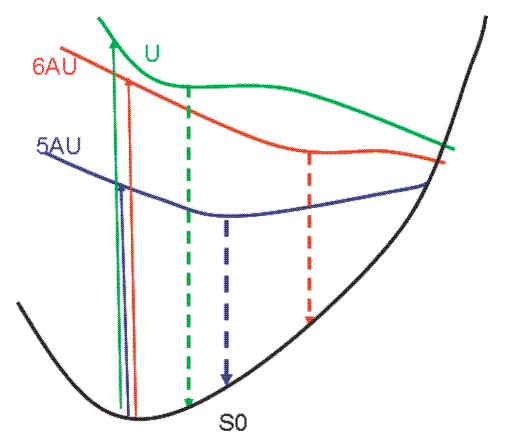
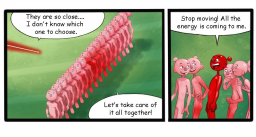
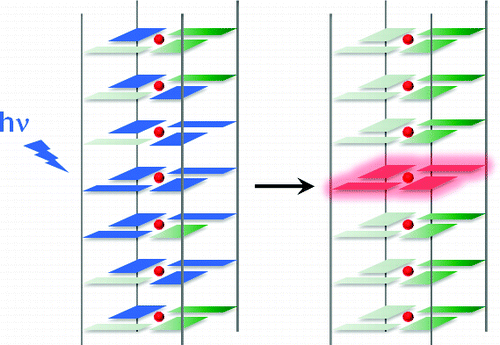

 G-quadruplex publications.pdf
G-quadruplex publications.pdf
